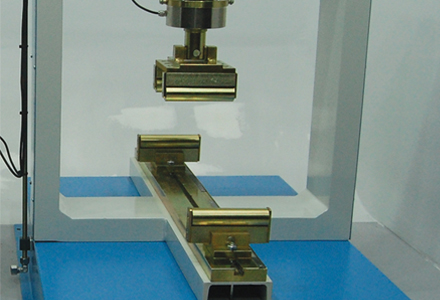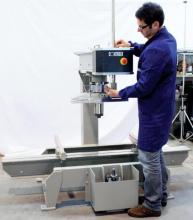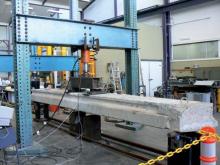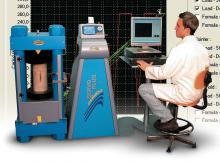One of the world's most versatile building materials is subject to a variety of tests to make sure it is fit for purpose. Patrick Smith reports

One of the world's most versatile building materials is subject to a variety of tests to make sure it is fit for purpose. Patrick Smith reports
The ability to be flexible in the test regime within a busy concrete testing facility is the key to effectively support the demands from the onsite requirements. The process of producing the final test results must be fast, accurate, but also simple, to reduce the need for highly skilled lab technicians. All of which, will increase productivity and reduce costs, says Test International, which has over 35 years' experience in the supply of engineering equipment to industrial and educational establishments, and which is based in the premises of testing equipment manufacturer"Having machines to test cubes, blocks and beams, which have menu-driven software requiring only minimum input, are the technician's dream. But procuring those machines with the ideal features can sometimes be a strain on the available budget," says Terry Wilson, Test International's managing director.
"A range of concrete testing equipment has been developed, which not only meet the demand for accuracy and repeatability, but also brings a quality product to the market at an affordable price." One example is the fully automatic flexural test machine: depending on the mix of test requirements, customers may wish to have a stand-alone flexural test frame or one that is driven by the power pack and software from the compression machine console, and both options are available from Test International in 100kn and 200kn versions. They are designed for testing concrete beams and traverse tests on kerbs and flagstones as well as indirect tensile tests on concrete and interlocking pavers.
"The stand-alone unit has all of the features of the Automatic range of compression machines which consists of four machines, covering 2000kN, 3000kN, 4000kn and 5000kn capacities. They are designed to meet the need for reliable and consistent testing of concrete samples, and feature a fully automatic test cycle with a closed-loop digital read-out." Each machine consists of three main parts: the frame, power pack and the acquisition and control system, and each part is designed to produce machines with a high degree of mechanical stability which comply to EN 12390-4; BS 1881 and ASTM C39 standards (with suitable platen set).
The Auto range offers automatic test cycle with rapid Approach; graphical, LCD data acquisition and control system menu-driven software for easy operation; load vs time plot and instantaneous load rate displayed; accurate load rate control within ±5% of selected rate from 1Kn/sec to 20Kn/sec.
Stress calculation for the standards of EN 12390-3, EN 12390-5, EN 12390-6, EN 1338, EN 1340, EN 196 are pre-loaded, while SI, metric, imperial units; data storage up to 1,250 tests; output for printer or PC and PC software for test control and advanced report print-out are also offered.
The welded steel frame carries a high precision ball seating upper platen, and will allow tests of concrete cylinders of 320mm long and 160mm in diameter as well as 100, 150, and 200mm cubes.
The dual-stage power pack is controlled by the data acquisition and control unit, and is designed to operate at very low noise levels, even when working at the top end of the test cycle.
The LCD graphics data acquisition and control system is designed to control the machine and processing of data from load cells or pressure transducers installed on the compression machine frame.
"The easy-to-read LCD graphic display and touch-button data pad keys make the unit quick and straightforward to operate. All interactions with the measuring system are via the front control panel by using simple menu-driven procedures," says Wilson.
"The digital graphic display allows real-time load vs time graph, and at the end of the test cycle, the results can be stored in the large memory or downloaded to a PC. A dedicated software package is available for further online data processing, database management and certificate printing." The system is available in English, Turkish and Russian, and can control two frames.
Methods and tools
Material and component manufacturers, material testing laboratories and civil engineering construction companies are now investing in the latest testing technology to increase productivity, improve safety and reduce costs, says ELE International."There are a number of methods and tools available for checking and evaluating the quality of concrete, and although many of these techniques have been in existence for some time three proven methods of testing fresh concrete at different levels of workability are the slump test, the flow table and Vebe Consistometer test," says the company. The slump test measures the consistency of freshly mixed concrete of medium consistency, and is the most widely used method for assessing its workability, while the flow table test is used where high workability mixes with a slump of 180mm or more are specified.
A third test for fresh concrete is the Vebe Consistometer test and is generally used with particularly stiff mixes.
"Hardened concrete density which can affect its durability, strength and resistance to permeability is determined both by simple dimensional checks and by weighing and calculation by weight in air/water buoyancy methods," says ELE.
Perhaps the most important test for hardened concrete is compressive strength testing, enabling engineers to assess the strength of a concrete sample and its performance under actual loading.
"The latest generation of compression testing machines offer extremely reliable results, automating a number of processes. Equipment typically combines a high stability load frame and control console with incorporated digital and microprocessor technology to provide highly accurate results. Closed loop microprocessor control is invaluable in today's compression testing machines, significantly increasing productivity and offering outstanding levels of accuracy and consistency in testing cycles." The company says its ADR Auto range can be used to provide accurate, detailed results recording and high throughput testing, both on site and in the laboratory.
The automatic machines require minimal operator involvement, and are said to improve productivity and reduce costs.
Machines compliant with the latest European EN specifications employ specially designed upper platen/ball seating arrangements to ensure there is no movement of the assembly after initial contact with the sample. Research has shown that any movement of the upper platen, coupled with frame deformation during the loading cycle of standard cube samples, can result in variances of measured strength.
Hydraulic systems incorporating automatic closed loop controlled loading with variable output pump benefit from a low temperature operating system, as the system delivers only the required amount of hydraulic fluid to meet the loading requirements.
"While much of the operation process is automated, users have access via a simple control panel for calibration, sample selection, test control, and options to save or print or download test data to PC," says ELE.
"By investing in testing, risk and uncertainty can be efficiently and cost effectively minimised, resulting in sound concrete structures."
Hardware and software
Meanwhile,The system enables elastic modulus and Poisson ratio [the ratio of transverse contraction strain to longitudinal extension strain in the direction of stretching force] to be measured using various types of sensors in accordance with the various international standards.
"It is now possible for the Eurotronic to dialogue with a remote PC in which to concentrate all complex input and output operations by means of dedicated software that operates in
Computerisation is extended to all the standard test routines now available involving compression, flexure, indirect tensile, paving blocks, load and speed control failure, elastic modulus, real-time acquisition and file acquisition.
With Tecnotest's KE Series machines, load pace regulation and test execution are automatic, and at the end of the test the machine stops, the ram returns to its original position and the results are shown.
"Using the Tecnotest software AD 050/B68, and the PC, user interface is improved while allowing a wider range of file management possibilities.
Measurement of elastic modulus takes full advantage of the capacity of the machine to follow positive, nil or negative pace rates, in compliance with the most widely diffused standards," says the company.
With the KD Series, load pace regulation is performed by the user by means of a hand-wheel, and the Eurotronic display shows whether or not it is necessary to reduce speed so as to follow the set load pace: generally speaking adjustment is needed only at the start of the test.
The Eurotronic display/readout unit firmware includes various test routines including compression for cubes, cylinders and blocks; flexure for beams with three or four-point loading and for beams or slabs; indirect tensile test for concrete; block pavers; controlled strain or stress, and elastic modulus and Poisson ratio.
Each routine requires data such as sample dimensions, sample ID and state of curing to be input as well as pace. At the end of the test, strength is calculated automatically, and all tests may be saved in an archive, downloaded via a USB cable to a PC or transferred from the Eurotronic to a USB flash drive for subsequent consultation on a PC using MS Windows applications such as Excel or Word.
"There are four readout channels supplied as standard which become eight using the expansion card. Each channel has a dedicated calibration screen and the readout range has 580,000 points resolution, thereby guaranteeing very high accuracy even during initial fractions of measurement."
Reference standards
According to Controls, considering that all the national specifications in Europe are now superseded by the new EN 196 it can outline that there are just two main reference standards for testing mortars machines: EN 196-1 and ASTM [American Society for Testing and Materials] C109.Other reference standards for testing mortars ASTM C348 and C349 require testing machines according to ASTM C109, says Controls.
"The main differences among the standards are basically the size of specimens and the specifications for the bearing compression plates and for the flexural jigs. The EN standard requires both the flexural and the compression test on 40x40x160mm mortar prisms; the ASTM C348, C349 require the same with a little difference in the flexural jig, while the ASTM C109 requires the compression test only on 50mm mortar cubes.
"Regarding the accuracy of the recorded load, both ASTM and EN standard state that the load applied to the test specimen shall be indicated with an accuracy of ±1% and EN prescribe the Class 1 starting from 1/5 of the full range." The company points out that in addition, both standards specify that during the test the load rate must be constant within a small allowable range (approximately 10% of the preset value) since the measurement of the mortar's strength is influenced not only by the preparation of the sample (for example by the curing) but also by the test execution, not least the load rate applied by the machine during the test.
"Even if most of the machines used in laboratories all over the world are manually controlled, an automatic control of the test is mandatory to get an accurate and constant load rate application without large fluctuations that not only guarantees the compliance with standards but also allows the test to be performed by different operators without influencing the test results," says Controls.
It says the new generation of automatic testing machines for mortars manufactured by Controls has been developed from continuous applications and research, closely involving universities and the construction industries, while upgrading testing machines to a higher level of quality testing, fully compliant to the strict requirements of International standards.
"In automatic machines the test cycle with closed-loop digital feedback is automatically performed by simply pressing the start button. The load time graph and the actual load rate are displayed in real-time during the test.
"Correct test execution, according to the selected standard, is continuously and automatically controlled and shown on the shown," says Controls.
It says its new Pilot 4 machine series features energy-saving technology, allowing an accurate oil flow control resulting in no oil dispersion, silent operation, cold oil temperature and low energy consumption (savings of over 30% compared to traditional systems are claimed), ensuring in the meantime the correct load rate according to the Standards.
"Accuracy is guaranteed by a rigid two steel column frame and updated hardware fitted with high-resolution analogical channels for connection to the load cells and with USB port for connection to PC allowing real-time acquisition and easy management of test data." Test certificates can be immediately obtained and include descriptive information, test results and load-time graph, meaning that test execution conforming to standards can be reported.

















